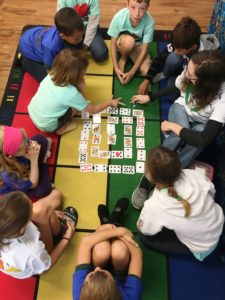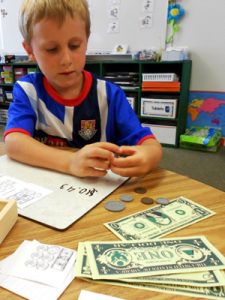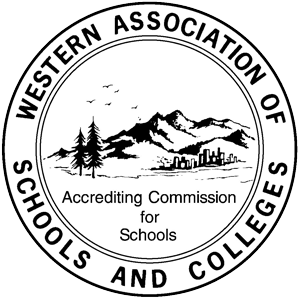Teaching and learning at Waimea Country School is informed by the latest research in brain science — namely, that students who embrace a growth mindset learn more and with greater understanding, and accept challenges and failures as opportunities to improve their skills and learning.

This approach is particularly important and effective in learning mathematics.
Developing number sense is key to success in mathematics. This means being fluid and creative in thinking about how numbers work so there is actual understanding that goes well beyond rote memorization of algorithms to make calculations.
All classes utilize a scope and sequence of skills and concepts based on the national Common Core Standards. Each grade level has a specific set of benchmarks on which teachers base year-long curriculum planning. While there are no school-wide adopted math textbooks, teachers pull from a wide variety of resources, such as Eureka Math and Khan Academy (online), to create a balanced instructional approach.
Visual representations and hands-on manipulatives are used by students at every level in math classes to teach concepts, build connections, and deepen understanding. Teachers use a wide range of instructional strategies, including small guided math groups, math centers, partner and small group activities, projects, one-on-one instruction, and so on, to meet the needs of each individual math student. Mental math strategies and problem-solving strategies are introduced and developed at every level.
In ‘Ohi’a class, children begin to gain an understanding of mathematical ideas. For that understanding to be meaningful, children need to be able to integrate and connect a variety of concepts in many different ways. The effective use of manipulatives helps children connect ideas and integrate their knowledge so that they gain a deep understanding of mathematical concepts.
For that understanding to be meaningful, children need to be able to integrate and connect a variety of concepts in many different ways. The effective use of manipulatives helps children connect ideas and integrate their knowledge so that they gain a deep understanding of mathematical concepts.
In Koai’a class, students often work in centers, which include a teacher-led guided math session used for teaching specific skills and concepts based on the needs of students. Other centers might include independent practice, partner or small group game play, problem-solving, math journaling, or review activities.
Key skills and concepts for this level include:
- Place value through 1,000s
- Addition and Subtraction, with and without regrouping
- Meaning of multiplication and division
- Basic shapes and their attributes
- Fractions as numbers
- Telling time
- Calculation with money
- Estimation and measurement of length, time, volume, and weight
- Application of key mathematical properties, such as the commutative property of addition and multiplication
 In Koa class, mathematics is taught both through direct instruction of specific computational skills and through the application of those skills in problem-solving exercises. Students learn and practice computational skills and problem-solving strategies and then apply those concepts to solve problems. Small class size allows students to work closely with teachers and peers and allows the teacher to address the specific needs of each individual student and challenge each appropriately.
In Koa class, mathematics is taught both through direct instruction of specific computational skills and through the application of those skills in problem-solving exercises. Students learn and practice computational skills and problem-solving strategies and then apply those concepts to solve problems. Small class size allows students to work closely with teachers and peers and allows the teacher to address the specific needs of each individual student and challenge each appropriately.
Basic Facts
Memorization of basic math facts is our goal, but memorization that comes from ongoing practice and engagement with math facts tasks, not memorization that comes from rote drill with no understanding behind it.
At all levels, students engage in activities designed to promote automatic recall of basic math facts. Through hands-on activities, direct teaching of strategies, and number talks, students master basic addition, subtraction, multiplication, and division facts. They then build on strategies related to these basic facts to work increasingly challenging problems.


